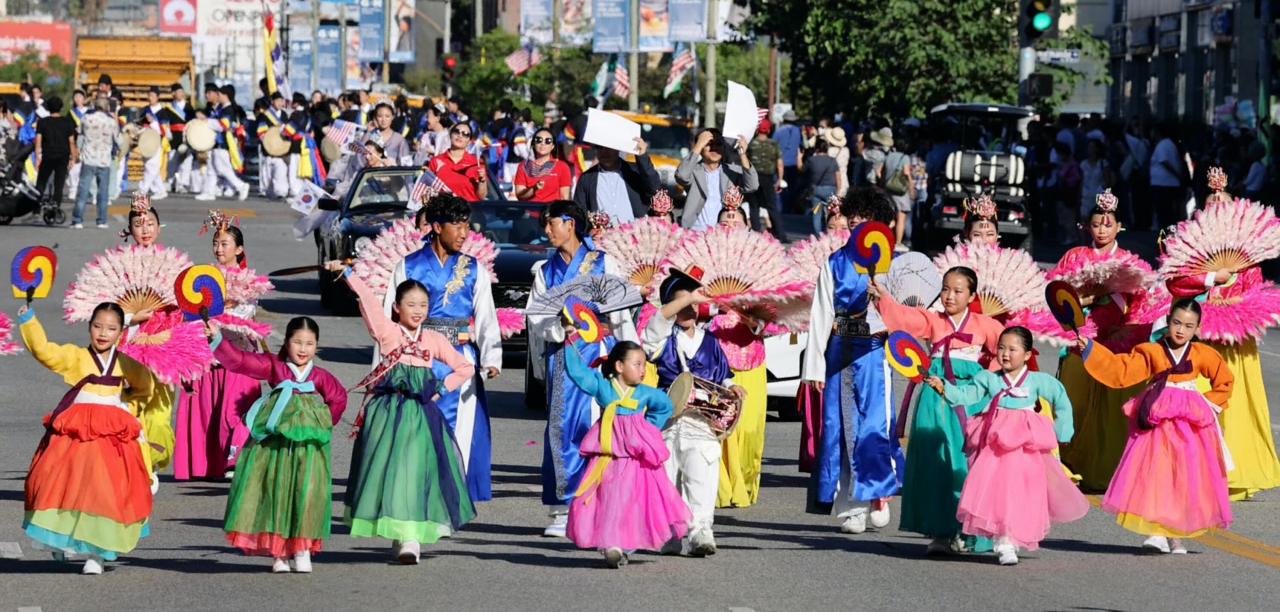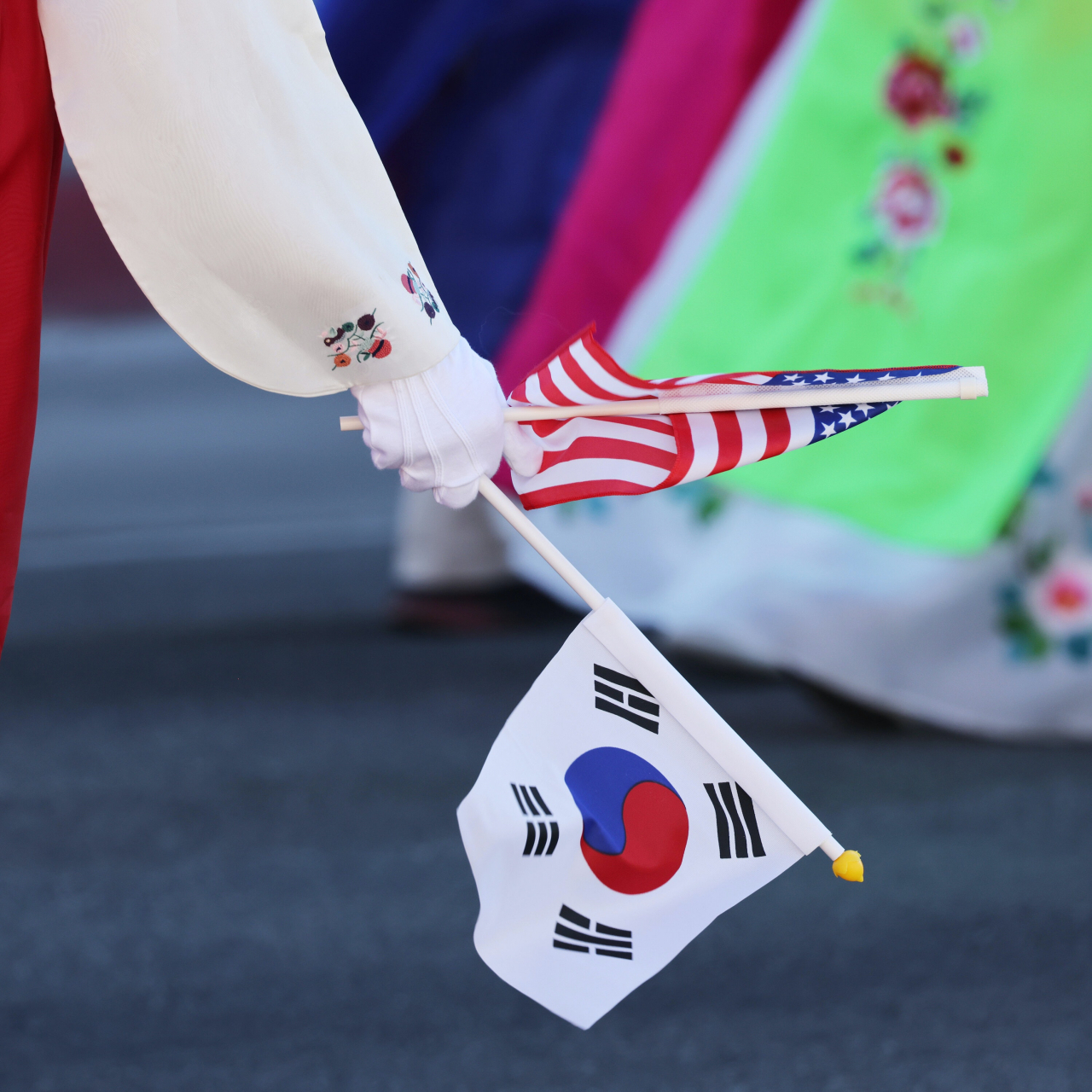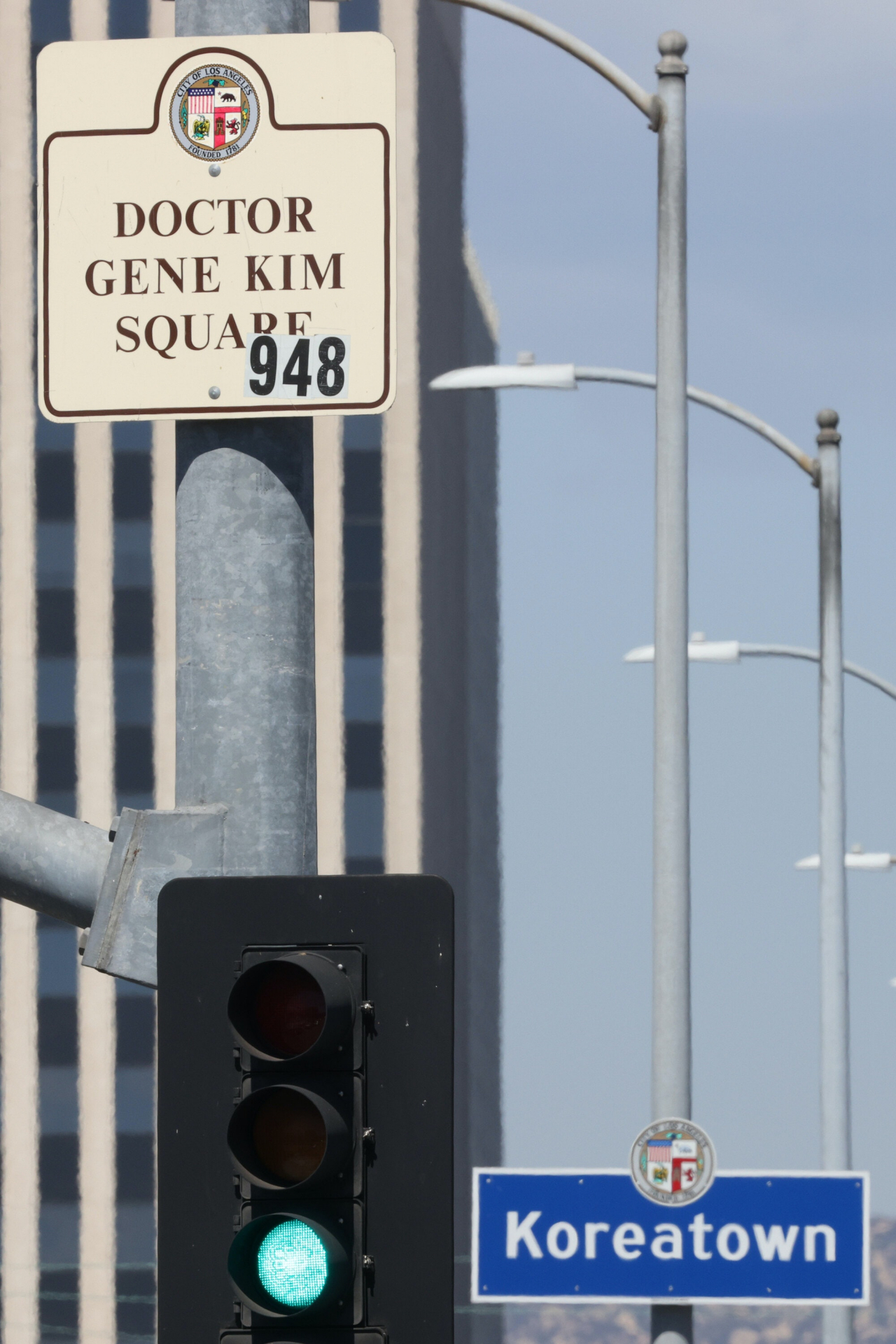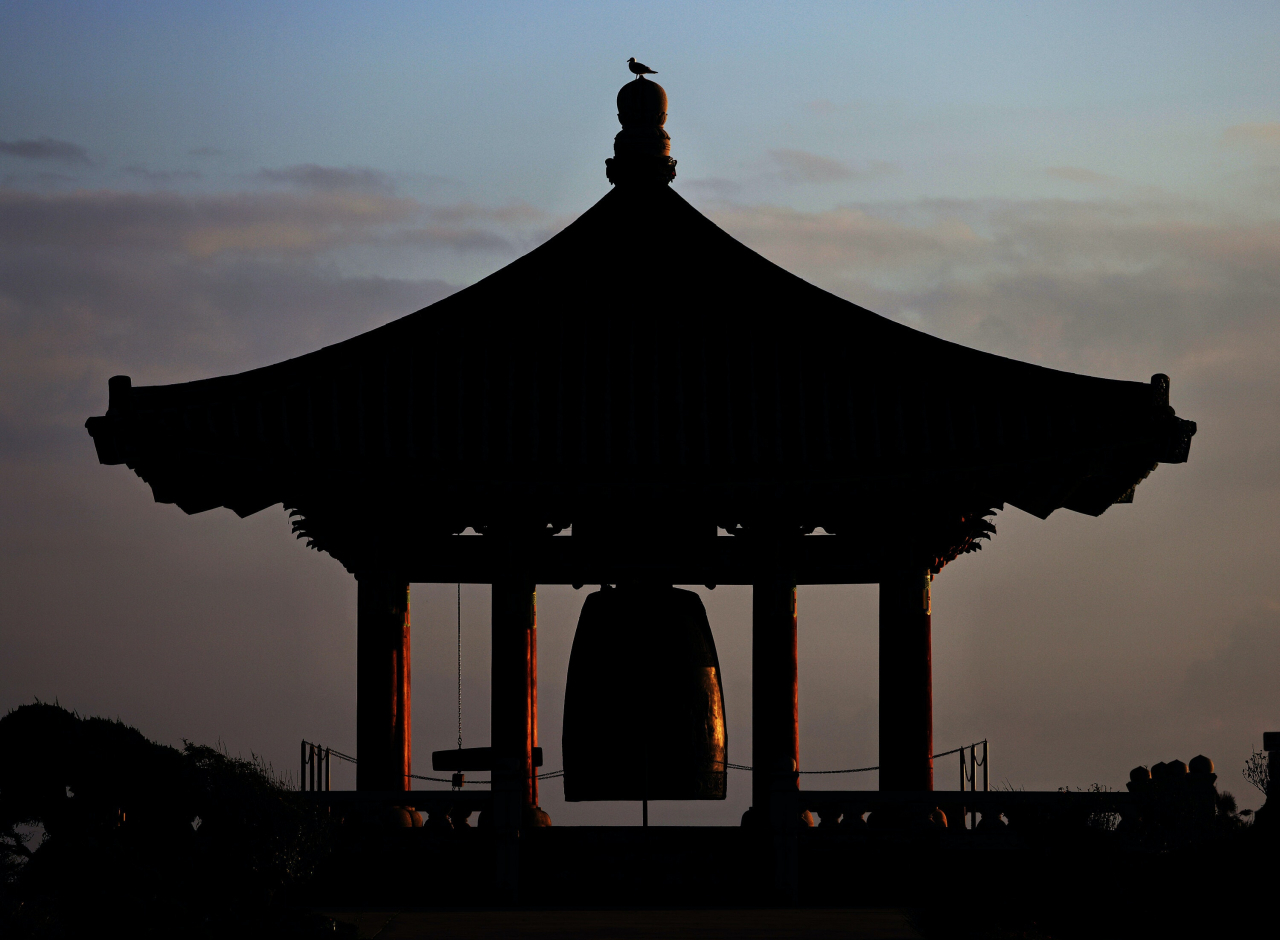 |
Young Korean American girls wearing colorful hanbok dance and walk while moving along the annual Korean Festival Parade in Los Angeles Koreatown on Sept. 24.Photo © Hyungwon Kang |
You can take Koreans out of Korea, but for some, you cannot take Korea away from Korean Americans. That's what leads to Korean America, a thriving Korean culture overseas that parallels the motherland.
Korean-language newspapers, radio and TV define Korean Americans as Koreans who live in the US away from their homeland.
Canada and the US are home to the largest numbers of Koreans outside of Korea, combining for some 3 million out of the 7.3 million documented Koreans living in 193 foreign countries, according to South Korean government data.
"Korean Americans have always been part of modern Korean history. They were directly engaged in the independence movement (in the early 20th century). Famous historical figures such as Syngman Rhee, Ahn Chang-ho and Seo Jae-pil were all Korean Americans," said Edward Chang, a professor at University of California, Riverside.
English-speaking Korean Americans have been at the vanguard of Korea's history since the 20th century.
"President Syngman Rhee was the most successful Korean American," said Cho Kap-che, a veteran Korean journalist who has written in depth about Rhee.
 |
The national flags of the US and South Korea are held by a hanbok-wearing participant at the 49th annual Korean Festival Parade in Los Angeles Koreatown on Sept. 24.Photo © Hyungwon Kang |
Syngman Rhee (1875-1965), who arrived in the US in 1904, raised funds from Korean Americans to fight for the liberation of Korea from Japanese colonial rule.
After Rhee returned to Korea following the fall of the Japanese colonial government in 1945, he was elected president of the Republic of Korea in 1948.
"It is no exaggeration to say that the Korean community in America was a foundation of Korea’s development,” said Cho.
After stepping down from the presidency in 1960 following mass protests against election fraud, Rhee went into exile in Hawaii. He died there in 1965. Hawaii was where Rhee had decades of enduring relationships with friends with whom he had spent many years together earlier in the first half of the 20th century.
Seo Jae-pil (1864-1951), also known as Philip Jaisohn, arrived in the US in 1885 and became Korea’s first naturalized US citizen in 1890. Seo founded the Dongnip Sinmun, or the Independent, the first newspaper in Hangeul that was also the first Korean-English bilingual newspaper.
While Korean Americans have greatly shaped modern Korea since the early 20th century, not all Korean Americans become naturalized citizens of the US or Canada, as is the case with other permanent residents of the US and Canada who enjoy plenty of rights nonetheless.
“Korean diaspora in America refers to Koreans who reside in America for a relatively long period of time,” said Chang at UC Riverside, who researches Korean Americans.
Except for a handful of intellectuals who went to the US seeking additional education, the first migration of Koreans to the US occurred in 1902 when a group of laborers left Korea in the winter of 1902, arriving to Hawaii on Jan. 3, 1903.
 |
The intersection of Vermont Avenue & Olympic Boulevard in Los Angeles Koreatown was named Dr. Gene Kim Square in 2014. The Los Angeles Koreatown sign went up in 1982 after the area was officially designated as Koreatown on Nov. 8, 1981.Photo © Hyungwon Kang |
Dosan Ahn Chang-ho (1878-1938), who arrived in America in 1902 to study, became a social reformer, an independence movement leader and the founder of America's first Koreatown in Riverside, California, in 1904.
Ahn led several grassroots organizations, including the Korean National Association, which linked Korean Americans during the darkest years in the motherland under Japan's 1910-45 colonial rule.
The Republic of Korea's constitution traces its origin to Korean Americans, who initially funded the formation of the Provisional Government of Korea in Shanghai, Republic of China in 1919, following the March 1 independence movement.
Early Korean Americans, under the guidance of intellectuals such as Ahn Chang-ho and Syngman Rhee, raised funds in the US to finance the independence movements back home.
In 1920, Korean Americans in California formed the first Korea Air Corps, which was the foundation of the Republic of Korea Air Force.
Following the 1950-53 Korean War, hundreds of thousands of Korean War orphans and Korean women married to US servicemen made up the second wave of migration of Koreans to the US.
Thanks to the American civil rights movement of the 1960s, the 1965 Immigration Act opened up immigration opportunities for more Koreans to move to the US.
 |
The Korean Bell of Friendship and Bell Pavilion, which South Korea gifted to the people of the US on its 200th birthday in 1976, is located at the Angels Gate Park in San Pedro, California.Photo © Hyungwon Kang |
In the 21st century, for Korean students seeking higher education and professional opportunities in the US, Korean America is synonymous with more life choices.
"Korean Americans have the best of both worlds. They are pioneers who left their beloved home in Korea and have a unique culture that includes the best of both American and Korean cultures," says Peter Pak, a Los Angeles Koreatown-based journalist for the past 33 years.
Korean culture is celebrated annually in most major US cities, but it all started with the formation of Los Angeles Koreatown by Dr. Gene Kim, 89, a successful businessman and the founder of the Koreatown Development Association, a nonprofit organization in Los Angeles. He personally financed the drawing up of the Los Angeles Koreatown plan that the Los Angeles City Council approved on Dec. 8, 1981.
Kim had laid the foundations for the geographical designation of Koreatown in Los Angeles with the annual LA Korean Festival starting in 1974.
"We needed to concentrate Korean businesses into a Koreatown area, to grow as a community," recalls Kim, 79, who has a street corner at Vermont Avenue & Olympic Boulevard dedicated in his name as the founder of LA's Koreatown.
 |
K.W. Lee, 94, a retired journalist who reported the unjust jailing of Chol Soo Lee (right), is pictured at his home in Rancho Cordova, California, on Sept. 25. Lee was one of the first Asian American journalists to work in the mainstream media in the US in the 1950s.Photo © Hyungwon Kang |
"The first Korean Festival Parade on Olympic Blvd. was on Sunday, Nov. 3, 1974. I applied for a permit for an estimated 3,000 spectators," said Kim.
The Los Angeles Police Department reported more than 30,000 parade spectators at the first Korean Festival Parade in 1974.
"Starting the following year, local and national politicians wanted to join the Korean Festival Parade. In fact, US Sen. John V. Tunney (1934-2018) from California who voluntarily participated in the Korean Festival parade in 1975, did not sit in the dignitaries' convertible. He walked the entire parade route shaking hands with as many Korean Americans as possible," Kim said.
"Korean America has always been very important to Korean history. Now the divided Korea and the reunification of Korea is probably largely dependent on Korean Americans. Korean Americans are in a position of influence in Washington DC on US policy," said Chang of UC Riverside.
By Hyungwon Kang (hyungwonkang@gmail.com)
--
Korean American photojournalist and columnist Hyungwon Kang is currently documenting Korean history and culture in images and words for future generations. -- Ed.
Correction
A version of the article published in the Oct. 7th print edition misstated the date of the Los Angeles City Council’s approval of the plan for the Los Angeles Koreatown. It was Dec. 8, 1981, not Nov. 8, 1981.
The article also misstated Dr. Gene Kim’s age. It is 89, not 79.




![[Herald Interview] 'Trump will use tariffs as first line of defense for American manufacturing'](http://res.heraldm.com/phpwas/restmb_idxmake.php?idx=644&simg=/content/image/2024/11/26/20241126050017_0.jpg)

![[Herald Review] 'Gangnam B-Side' combines social realism with masterful suspense, performance](http://res.heraldm.com/phpwas/restmb_idxmake.php?idx=644&simg=/content/image/2024/11/25/20241125050072_0.jpg)
![[Health and care] Getting cancer young: Why cancer isn’t just an older person’s battle](http://res.heraldm.com/phpwas/restmb_idxmake.php?idx=644&simg=/content/image/2024/11/26/20241126050043_0.jpg)